The year 2025 is shaping up to be a goldmine of trending products for savvy online sellers. Thanks to Google Trends product research, merchants can pinpoint rising consumer interests early and stock the next bestseller before the competition. In this comprehensive guide, we’ll explore how to use Google Trends as your secret weapon for finding trending products 2025, walk through step-by-step instructions, and highlight the top 15 Google Trends products to sell in 2025. By tapping into Google’s vast search data, you can base your product decisions on real consumer demand rather than guesswork – a sure recipe for e-commerce success.
What is Google Trends?
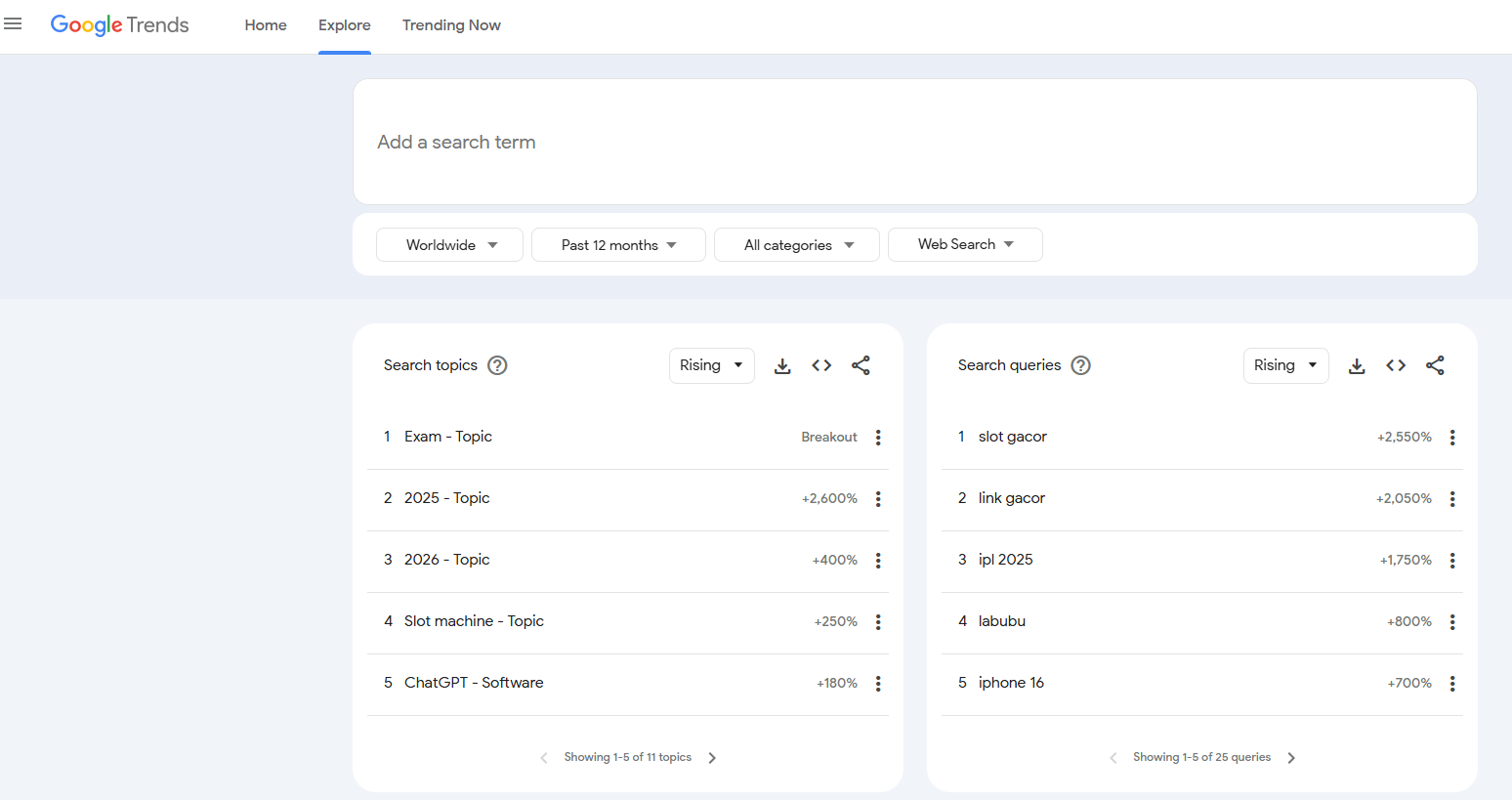
Google Trends is a free analytics tool from Google that shows how often people search for specific terms over time on Google’s search engine. In other words, it reveals what’s popular by tracking relative search interest for a keyword on a 0 to 100 scale (100 being the peak popularity for the time period selected). Google Trends doesn’t show exact search volume by default, but it visualizes search trends – whether interest in a topic is rising, falling, or stable. Because Google processes over two trillion searches a year globally, Trends effectively offers a window into the collective curiosity of internet users.
For online sellers, Google Trends serves as a real-time barometer of market demand. You can type in any product name or category and instantly see its popularity trajectory over time, interest by region, and related rising searches. It’s like having access to billions of consumers’ shopping intent at your fingertips. In summary, Google Trends “shows how many people are searching for a particular phrase”, helping retailers gauge how popular a product is by search demand. Whether you’re validating a product idea or comparing which of two niches has more buzz, Google Trends provides the data-driven insights to make informed decisions.
Top 15 Google Trends Products to Sell in 2025
Leveraging the power of Google Trends, we’ve identified 15 unique product opportunities that are poised to perform well in 2025. These trending products 2025 span various niches – from beauty and wellness to tech, home, and sports – but all share one thing in common: rising consumer interest, as evidenced by Google search data. Unlike generic items that everyone is already selling, these picks are lesser-covered product ideas that still have growing demand and room for new sellers. Below we’ll dive into each product, explain why it’s trending (with Google Trends insights), and how you might capitalize on the trend.
1. Mouth Tape (Sleep Strips)
2. Flat Back Earrings
3. Glass Straws
4. Sauna Blankets
5. Sleep Bonnets (Silk Hair Bonnets)
6. Blue Light Therapy Devices
7. Hair Repair Masks
8. Sleep Earbuds
9. Hard Water Shower Filters
10. Hair Texture Powder
11. Vanity Travel Bags (Travel Makeup Organizers)
12. Electric Pepper Grinders
13. Padel Rackets
14. Toe Spacers
15. Rotating Car Seats
1. Mouth Tape (Sleep Strips)
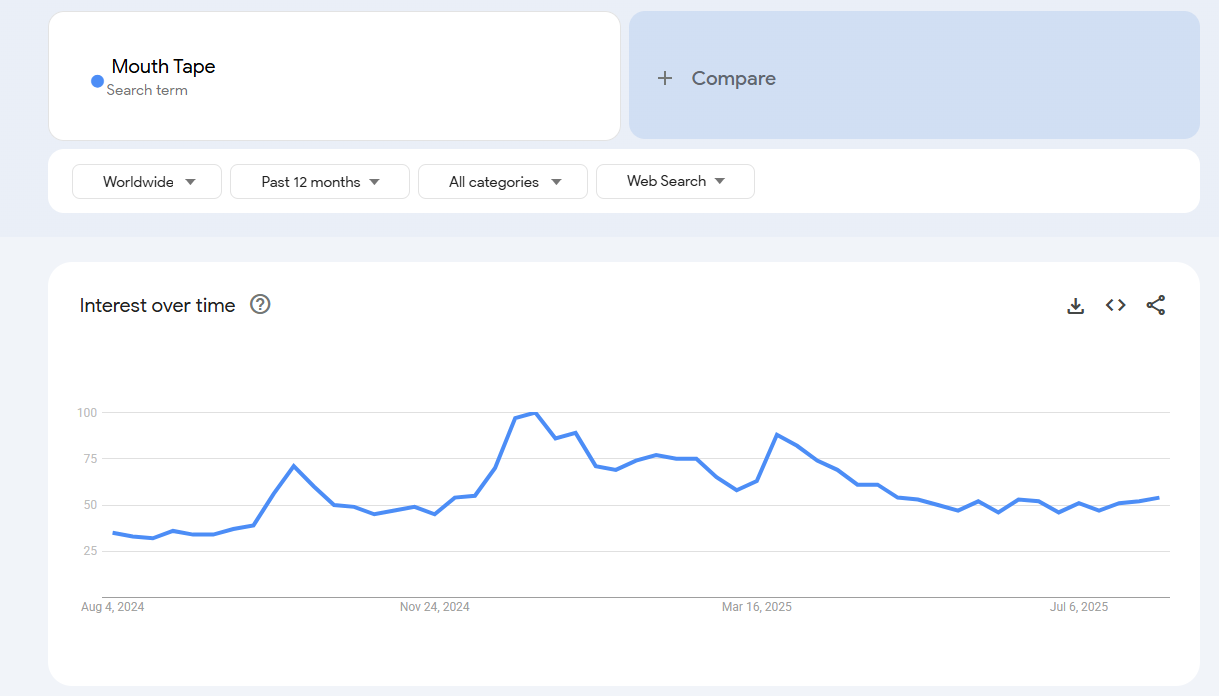
Google Trends data for “Mouth Tape” shows a meteoric rise in interest from late 2022 through 2025, confirming its breakout status as a sleep aid. Mouth tape – strips of specialized tape worn over the lips during sleep – has surged in popularity as people look for solutions to snoring, dry mouth, and better breathing at night. Google Trends identifies mouth taping as one of the fastest-growing sleep wellness trends, reflecting a broader consumer focus on optimizing sleep quality. The concept went viral as users shared experiences of improved sleep and reduced snoring, driving curiosity and searches. Manufacturers have jumped in with branded “sleep strips” (essentially mouth tape marketed for nightly use), often sold at premium prices to consumers willing to pay for a good night’s sleep. The appeal lies in its simplicity – it’s a non-invasive, drug-free hack for better sleep. For sellers, mouth tape represents a relatively untapped niche. You could offer multipacks of hypoallergenic mouth tape or position it alongside related products (like nasal dilators or anti-snore pillows). With search interest skyrocketing (up 134% YoY) and hundreds of thousands of monthly searches【7†】, this formerly obscure product has proven demand.
2. Flat Back Earrings
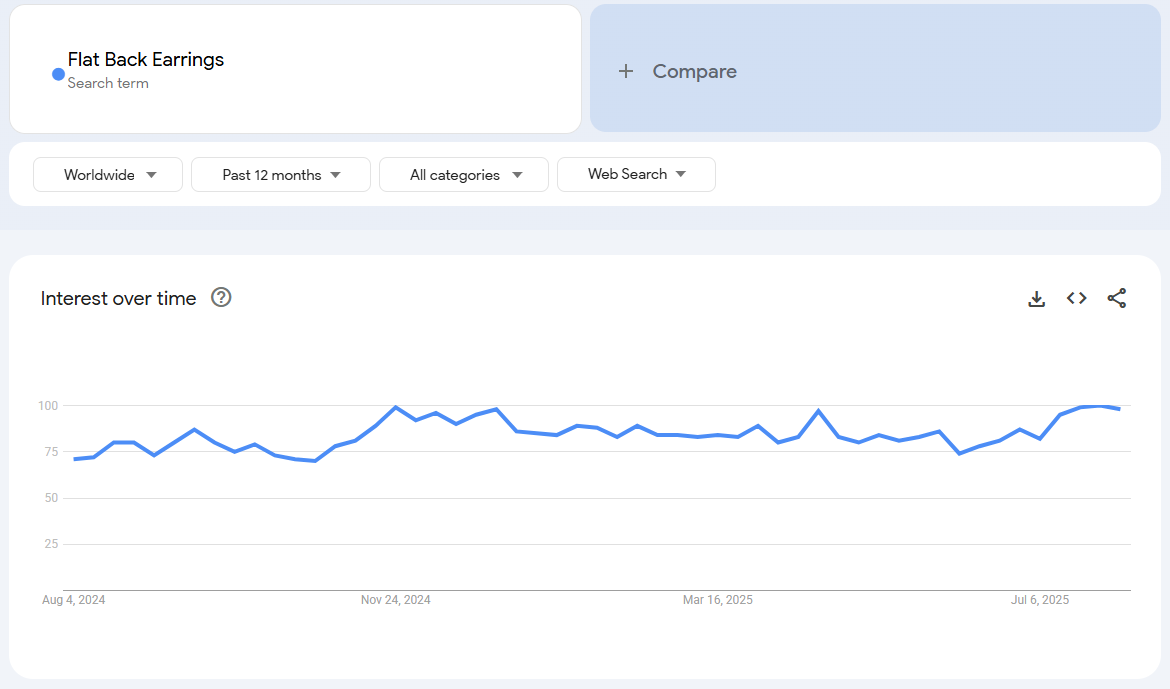
Google Trends for “Flat Back Earrings” shows steady growth in search interest, especially ramping up in 2024–2025 (about 136K monthly searches and climbing). Flat back earrings are an emerging favorite in the jewelry world, and Google Trends data reflects their climb in popularity. Unlike traditional earrings with protruding posts and clutches, flat back earrings have a flat, smooth backing that lies flush against the ear. Why the hype? Comfort and convenience. They’re designed to be worn continuously – even while sleeping – without poking into your neck. As more people get piercings (over 30% of Americans born since the mid-1970s have at least one, far higher than previous generations), the demand for comfortable earring designs has risen. Flat backs solve a common pain point, so much so that they’ve become a top jewelry trend rather than a niche accessory. An interesting driver behind this trend is parents seeking safer earrings for their kids. Flat back (or “safety back”) earrings don’t snag or irritate, making them ideal for children and even babies with newly pierced ears. Additionally, the multiple ear piercing trend (curated ear “stacks”) means people are leaving earrings in 24/7, further fueling demand for styles that won’t jab while sleeping. For sellers, flat back earrings present a great opportunity: they cater to a broad audience (from fashion-forward adults to cautious parents). You could offer them in various designs – studs, tiny hoops, etc. – and emphasize their comfort in your marketing. With consistent upward search interest and social media showcasing ear-piercing aesthetics, flat back earrings are set to shine in 2025.
3. Glass Straws

Google Trends chart for “Glass Straw” (125K monthly searches) shows a clear upward trend as we approach 2025, indicating growing interest in sustainable drinking options. Single-use plastics are out; reusables are in. Glass straws have emerged as a trending eco-friendly product riding on the sustainability wave. Back in 2018, many places began banning plastic straws, which led consumers to seek alternatives. While paper straws were an early substitute, they’ve been widely disliked for getting soggy. Metal straws gained traction for a while but have drawbacks (metallic taste, not transparent, can’t see if they’re clean). Enter glass straws: stylish, reusable, and taste-neutral. Google Trends shows that around 2020, searches for “glass straw” overtook those for “metal straw” and have since doubled in volume. This indicates a significant shift in consumer preference. Beyond the environmental motive, another factor behind the trend is dental health and aesthetics. Many people (especially coffee and wine drinkers) use straws to prevent teeth staining. Glass straws are perfect for this purpose – they’re reusable and you can ensure they’re clean due to their transparency. Health-conscious consumers also appreciate that high-quality glass straws are BPA-free and won’t leach flavors or chemicals. Overall, glass straws tick multiple boxes: eco-friendly, health-conscious, and visually appealing (they often come in attractive colors or even artistic designs). For sellers, offering sets of glass straws (often with cleaning brushes and cases) is a smart move. The interest is steadily growing as sustainability continues to be a key purchasing driver. Pair them with messaging around reducing plastic waste and protecting your smile, and you’ve got a compelling product for 2025.
4. Sauna Blankets
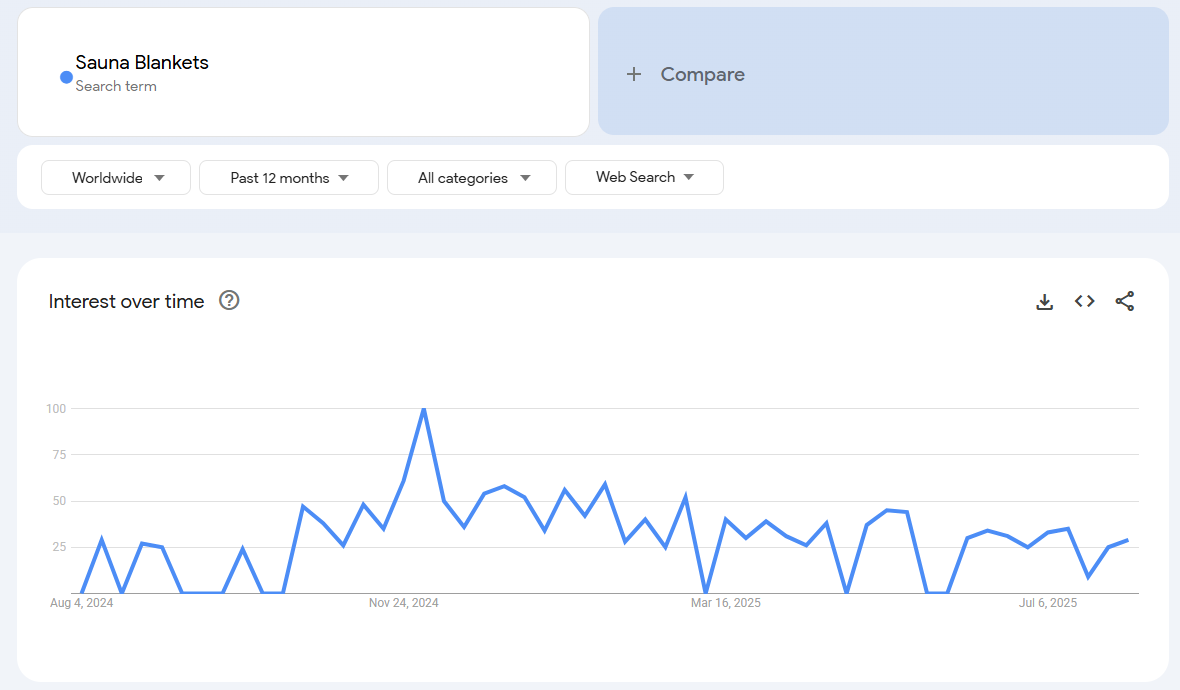
Google Trends for “Sauna Blanket” shows rising global interest with seasonal fluctuations, then a sharp climb in late 2024 into 2025. Searches now reflect about 80K monthly volume and climbing. Sauna blankets are heating up (literally and figuratively) as a top wellness trend. Not everyone has the space or money for a home sauna, but people still crave the detox and relaxation benefits of a good sweat session. A sauna blanket offers a convenient, portable alternative: it’s essentially a sleeping-bag-like device with infrared heating that simulates a sauna’s warmth. Over the past couple of years, Google Trends has captured increasing search interest in sauna blankets as an at-home spa solution. The concept especially took off as folks sought wellness treatments at home during and after pandemic lockdowns. Now, even with gyms and spas open, many continue to use sauna blankets to supplement their routines – it’s private and you can use it while relaxing on the couch. Trends data over a five-year period shows a general upward trajectory with some seasonality (interest may dip in warmer months and spike in winter when a portable sauna at home is extra appealing). By late 2024, the term started peaking to new highs, signaling that sauna blankets have gone from niche to mainstream awareness. They’ve been touted across social media by influencers claiming benefits like glowing skin, muscle recovery, stress relief, and calorie burn. Essentially, a sauna blanket taps into the huge health & wellness trend of personal self-care gadgets. For entrepreneurs, this product holds promise: it’s higher price-point but high perceived value, and you can build content around its benefits. Selling it may require educating customers on usage and safety, but the demand is clearly there.
5. Sleep Bonnets (Silk Hair Bonnets)
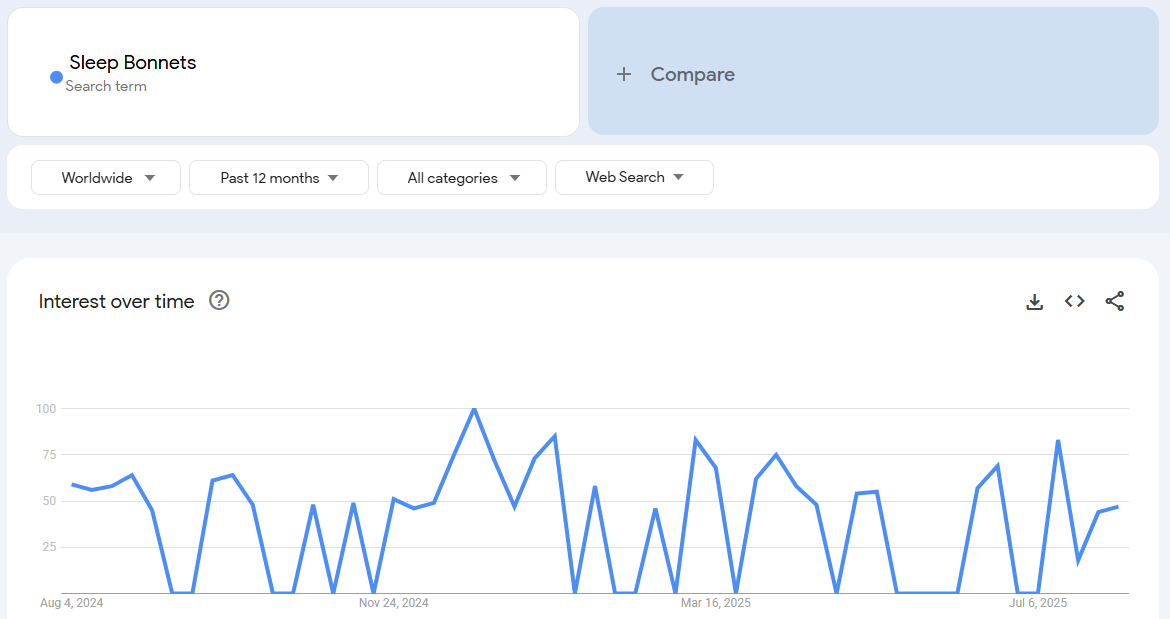
Google Trends interest for “Sleep Bonnet” (also known as silk bonnets) has climbed steadily, with a notable 64% YoY growth by 2025 – a strong indicator of this product’s rising popularity. The humble sleep bonnet has transformed into a must-have beauty accessory, thanks to growing awareness of hair care best practices. These are soft caps (often made of silk or satin) worn over hair overnight to protect it from friction. Over the past five years, sleep bonnets have steadily risen in popularity on Google searches. A big driver behind this trend is the natural hair movement and the general consumer shift toward protective hair care. People have learned that ordinary cotton pillowcases can cause hair breakage, frizz, and moisture loss. Silk bonnets provide a solution by creating a smooth barrier between hair and pillow. They’ve especially been embraced in Black hair care routines (where wrapping or covering hair at night is common to preserve styles and hair health), but have now crossed into the mainstream as all hair types seek frizz-free beauty sleep. TikTok and YouTube tutorials have played a role too – influencers demonstrated their nighttime routines and highlighted silk bonnets as their secret to healthier, shinier hair. Another interesting point from Google Trends and market analysis: sleep bonnets offer a cost-effective alternative to silk pillowcases. Not everyone will splurge on a whole set of silk bedding, but a bonnet is an affordable step with similar benefits for hair. Additionally, sleep bonnets cater to the growing self-care trend of turning bedtime into part of the beauty regimen – much like face masks or special sleep earbuds (another product on our list). For sellers, there’s an opportunity not only to sell attractive, high-quality bonnets (in various colors or with adjustable bands for comfort) but also to educate consumers. Emphasize the benefits – reduced frizz, preserved hairstyles, extended time between washes – and consider pairing bonnets with related products like satin pillowcases or hair masks. With search interest and consumer awareness climbing, sleep bonnets are moving from a niche item to a nightly essential for many in 2025.
6. Blue Light Therapy Devices
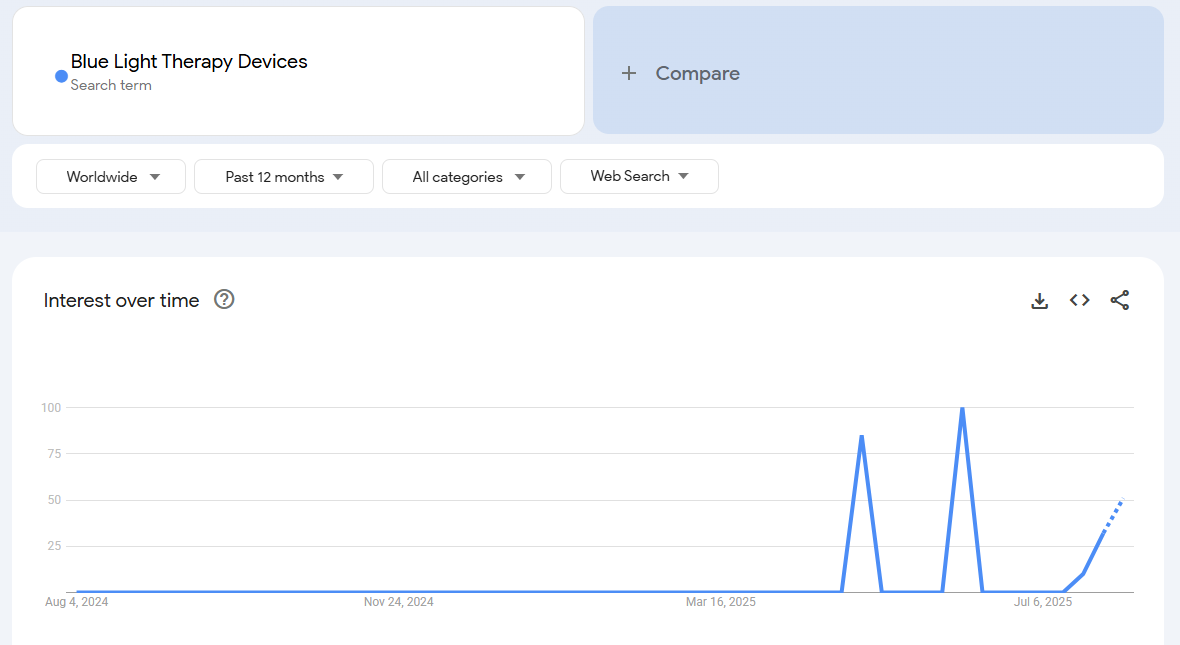
Google Trends for “Blue Light Therapy Light” (used for skincare) shows growing interest, particularly a notable rise in late 2024 into 2025 (roughly 150K searches/month now). It’s a clear upward trend as this beauty tech gains traction. Blue light therapy devices – often handheld wands or masks emitting blue LED light – are emerging as a hot item in beauty tech. These devices are used primarily to treat acne and skin damage. While red light therapy has been popular for a while (for anti-aging and inflammation), the blue spectrum is now catching on for its antibacterial properties in fighting acne-causing bacteria. According to Google Trends and industry sources, the searches for blue light therapy are growing rapidly, albeit from a smaller base compared to red light therapy. In fact, blue light queries are under 5% of red light’s volume currently, but rising at a similar rate, indicating a lot of headroom for growth without the market saturation of red light devices. This represents a unique opportunity: sellers can capitalize on consumers’ trust and familiarity with light therapy as a concept (thanks to red light’s success) while offering a product that targets a different need (acne) in a less crowded space. The timing is great – in 2025, many people have either tried or heard of LED skincare tools, and they’re becoming more affordable. Blue light devices in particular have benefited from positive press and derms endorsing at-home acne treatments. They appeal to those who want to level-up from topical skincare to high-tech solutions. Plus, with everyone taking Zoom calls and selfies, clear skin continues to be a high priority. For an online store owner, adding a blue light therapy gadget could attract a savvy skincare audience. The key will be differentiating with quality (wavelength, safety features, FDA-clearance if applicable) and education on usage (frequency, duration, combining with serums, etc.). The Trend trajectory is upward – as one source noted, sellers have a chance to ride the interest in light therapy without diving into the already saturated red light market. In short, blue is the new red in skincare, making these devices a bright spot for 2025.
7. Hair Repair Masks
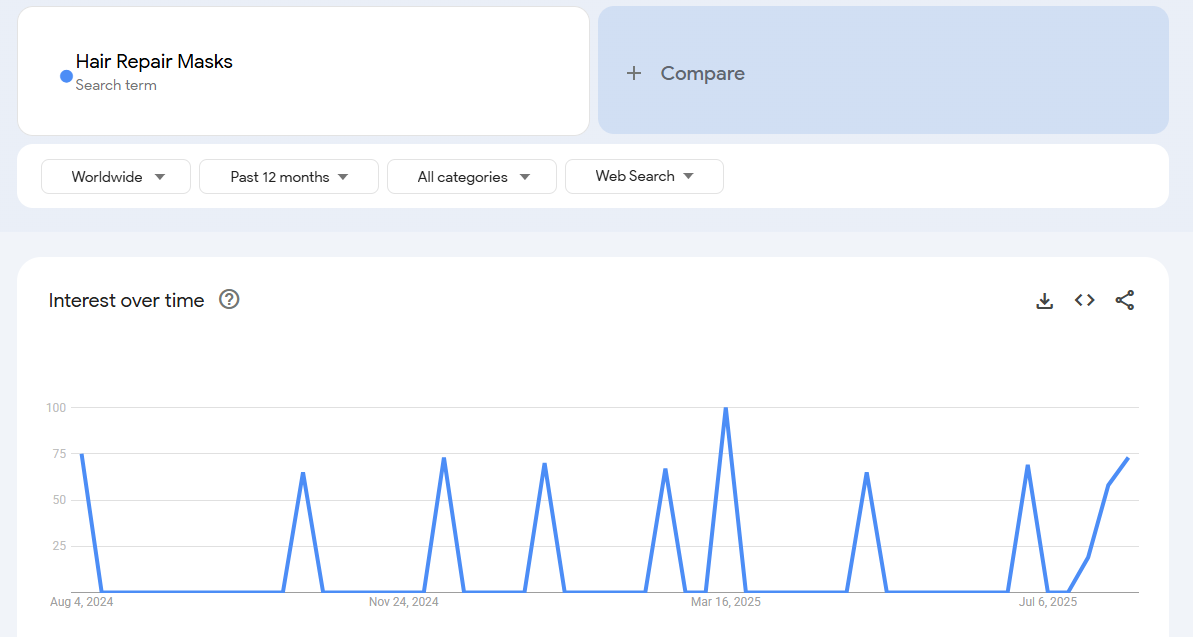
Google Trends chart for “Hair Repair Mask” shows a solid uptrend through 2024 into 2025 (now ~73K searches per month), indicating growing interest as consumers invest in hair health. Hair repair masks (deep-conditioning treatments aimed at restoring damaged hair) are seeing a notable uptick in popularity. This trend aligns with a broader consumer shift: people are willing to invest more time and money to achieve strong, healthy hair. Over the past couple of years, Google search interest in hair masks and bond-repair treatments has grown steadily. Several factors are driving this. First, the pandemic era saw many experiment with DIY hair coloring or skip salon visits, leading to more damage that needed fixing. Even beyond that, the rise of heat styling tools and color treatments means there’s a constant need for products that can repair dryness, split ends, and breakage. Hair repair masks promise salon-like results at home, making them very attractive to a wide audience (from curly hair enthusiasts doing weekly deep conditions to bleach-blonde folks repairing chemical damage). Importantly, this product trend is part of a larger beauty movement focusing on targeted, specialty treatments. Just as skincare exploded with serums for every concern, hair care is expanding with masks, bond builders, and scalp treatments for specific needs. Many of these masks feature buzzworthy ingredients like keratin, argan oil, collagen, or proprietary bond-repair formulas (inspired by the success of brands like Olaplex). For ecommerce sellers, hair masks are a relatively low-barrier product – they’re consumable (repeat purchase potential), easy to ship, and can be white-labeled with custom branding if you create your own. To stand out, you might focus on a particular niche (e.g., a vegan mask for curly hair, or a mask specifically for post-color treatment). The trend data shows sustained growth, meaning this isn’t a flash-in-the-pan fad but rather an “expanding range of targeted beauty products” trend. Hair repair masks fit perfectly into that narrative, and 2025 is shaping up to be a year where treating one’s hair to some extra TLC is very much in vogue.
8. Sleep Earbuds

Google Trends interest for “Sleep Earbuds” has been on a steady climb, picking up pace through 2024–2025 (currently ~57K searches/mo). This indicates more people are looking for specialized earbuds for better sleep. Sleep earbuds are a niche offshoot of the massive wireless earbud market, tailored specifically for nighttime use. Unlike regular earbuds, these are designed to be ultra-small, comfortable, and often have features like noise masking or soothing sound playback to help users sleep better. The idea has gained traction as more people struggle with falling asleep due to noise (snoring partner, loud neighbors, city sounds) or simply use audio like white noise/meditations to drift off. Google Trends shows growing interest in this category, which aligns with the post-AirPods era where wearing earbuds is normalized even outside traditional use cases. Essentially, Apple’s AirPods broke the ice, and now niche markets are flourishing for earbuds optimized for various scenarios: workouts, gaming, and yes, sleeping. One prominent example was Bose’s Sleepbuds a few years back, which, although discontinued due to some issues, proved that a dedicated market exists for bedtime ear devices. Now new brands have entered, learning from past mistakes and improving battery life and comfort. People are searching for terms like “best earbuds for sleeping” as indicated by the upward trend – they want something that won’t protrude or fall out when they turn on the pillow. Some sleep earbuds also double as earplugs (blocking external sound) while playing gentle soundscapes or pink noise. For sellers, this is a great product to target a specific problem: inability to sleep due to noise is a common complaint. By 2025, the concept is familiar enough that you won’t be introducing something completely foreign to customers, but it’s still novel enough that not everyone is selling it. Marketing can tap into both the wellness angle (better sleep = better health) and the tech angle (advanced miniaturized earbuds). Since many existing audio brands focus on general use or sports, positioning your product squarely for sleep – with testimonials about improved sleep quality, etc. – can attract a devoted customer base. As the trend suggests, these niche earbuds are part of an expansion of wearables into every facet of life, including our nightly rest.
9. Hard Water Shower Filters
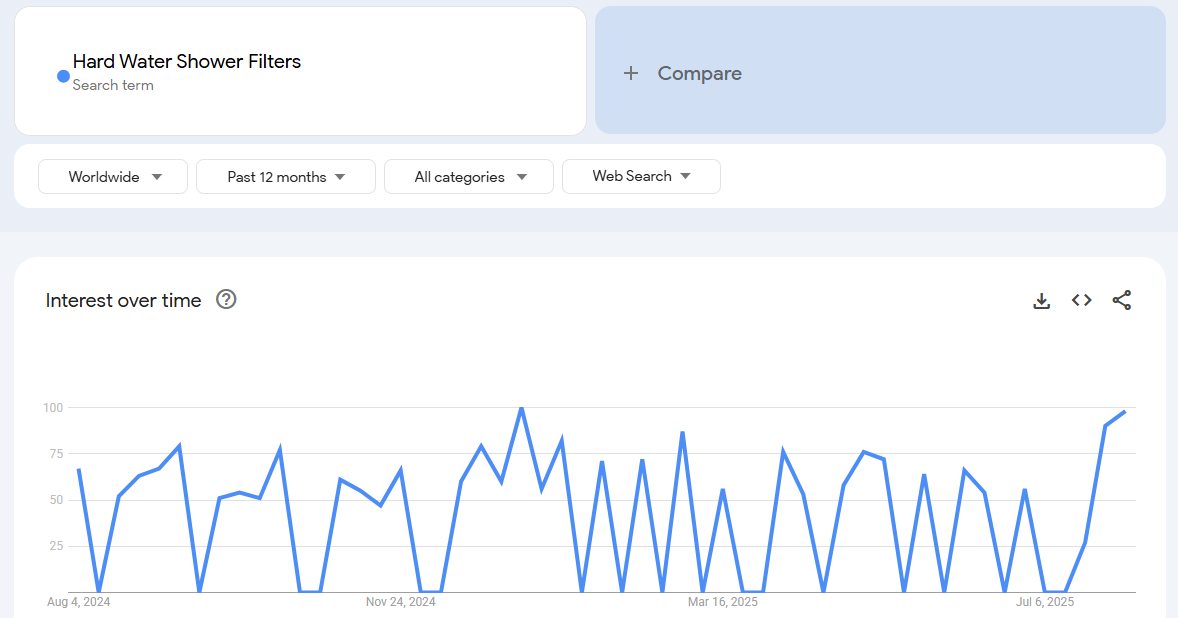
Google Trends for “Hard Water Shower Filter” shows a rising trend through 2023–2025 (approx 55K searches/mo now), reflecting increased interest in filtering shower water for beauty/health reasons. Shower filters for hard water are becoming a quietly booming product in the beauty and home care intersection. Hard water – water with high mineral content like calcium and magnesium – is a common issue in many cities and regions. It can leave hair and skin dry and dull by depositing mineral residue. As consumers invest more in skincare and haircare, they’re realizing that water quality can be a missing piece of the puzzle. Why spend on fancy moisturizers if your shower water is undermining your efforts? This thinking has led to a growing focus on shower filters that soften water by removing those harsh minerals. Google search interest has been climbing as people search for solutions to combat dry skin, brittle hair, or even issues like scalp irritation that can be aggravated by hard water. A telling statistic: consumers spend over $10 billion a year on moisturizers globally, and yet if they rinse with hard water, they might be negating some benefits. Filter brands cleverly pitch filters as a way to protect that investment in personal care. Essentially, a shower filter is sold not just as a plumbing gadget but as a beauty accessory that can save your hair color, keep your skin softer, and even extend the life of your shampoos and soaps (which lather better in soft water). This positioning has broadened the appeal of shower filters beyond the niche of water quality geeks to the much larger beauty-conscious audience. For sellers, hard water filters (typically attachments that screw onto the shower head or between the shower arm) are a promising product. They have recurring revenue potential too, since filters need cartridge replacements every few months (like a Brita for your shower). You could sell the filter unit and then the refills. Make sure to highlight benefits with before-and-after examples: e.g., vibrant hair color retention, reduction in eczema or dryness, etc. With environmental toxins and self-care being hot topics, shower filters check both boxes – they’re preventative care against environmental damage. The upward trend indicates more people are becoming aware of this solution, but it’s still far from saturated. If you can tap into local markets known for hard water (perhaps geo-targeted ads), you’ll hit a pain point many didn’t realize had a fix.
10. Hair Texture Powder

Google Trends chart for “Hair Texture Powder” shows interest exploding in 2024–2025 (106K monthly searches and over 100% YoY growth), mirroring its rise as a go-to styling product. Hair texture powder (also called volumizing or texturizing powder) is riding a major trend in hairstyling. These powders come in small shaker bottles and when applied to roots or strands, they add instant grit, volume, and fullness to hair. Originally popular among professional stylists, they’ve broken into the consumer market big time. The trend really took off alongside the craze for effortlessly tousled, “lived-in” hairstyles. Rather than heavy hairsprays or mousses, many people (women and men alike) are opting for lightweight powders that give a matte, natural volume especially to fine or thinning hair. Google Trends data shows search interest for these products skyrocketing, more than doubling in recent times. One factor is that men’s grooming has embraced hair texturizers as well – with more men seeking solutions for thinning hair or just wanting that thick, textured look, products like texture powder (which is easy to use and invisible in hair) have gained a male following too. The powders are also popular for updos and braids, giving extra grip so styles hold better. Another adjacent trend feeding this is the focus on hair loss solutions and prevention. As people explore ways to combat hair thinning (from supplements to treatments), they’re also looking for cosmetic fixes that make hair appear fuller. Hair texture powder fits nicely as a non-medical, instant fix to create the illusion of volume – it’s like a confidence boost in a bottle. For ecommerce, this product is attractive: small, inexpensive, and with repeat purchase potential (since the bottles eventually run out). You can also bundle it – for example, as part of a “volume kit” with a thickening shampoo and a texture powder together. The SEO around it is rising (just look at that 104% YoY search growth in the Trends graph!), which means content marketing (blogs/videos on “how to use texture powder for volume”) can pull in interested buyers. Since multiple brands exist, you might differentiate by ingredients (maybe a natural/vegan formula) or target a sub-niche (like a powder specifically marketed for men’s hair or curly hair, etc.). Overall, the demand trajectory is strong, indicating hair texture powders are not a one-season wonder but a staple styling product for the foreseeable future.
11. Vanity Travel Bags (Travel Makeup Organizers)
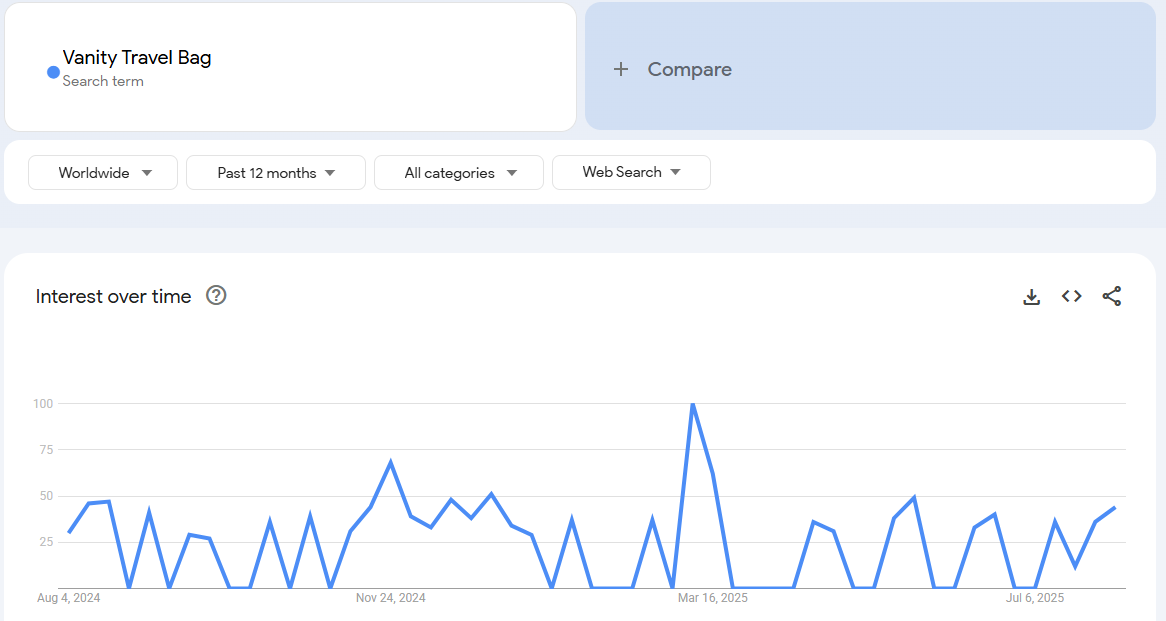
Google Trends for “Vanity Bag” (travel makeup/toiletry bag) shows a solid rising trend, with interest particularly jumping in 2024–2025 (currently ~206K searches/mo, up 66% YoY). This signals growing demand for better travel organization solutions. With more people working remotely or hybrid, the world has seen an uptick in travel – whether it’s “workcations” or simply making up for lost vacation time. One consequence is increased demand for travel organization gear, and high on that list are vanity bags – essentially chic travel makeup bags or toiletry organizers. Google Trends confirms this, showing vanity bags and related terms gaining popularity as consumers look for ways to keep their personal care items organized on the go. Unlike basic pouches, today’s trending vanity bags often have multiple compartments, slots for makeup brushes, spill-proof sections, and stylish designs that double as a mini vanity on the road. A few factors drive this trend. First, self-care routines have expanded; the average woman now uses several skincare products daily (one stat says five products each evening on average). All those serums and creams need to be toted along during travel, necessitating a more sophisticated bag than the freebie pouch that came with a makeup set. Second, the boom of influencers and YouTube travel bloggers showing “what’s in my travel bag” has elevated the travel organizer to a must-have accessory (both functional and aesthetic). Third, with remote work, people are more nomadic – working from cafes, coworking spaces, or hopping on short trips. Over 40 million Americans work hybrid jobs now, which correlates with more frequent travel. Being organized is key when you’re mobile, hence the popularity of well-designed travel bags. For sellers, vanity bags hit a sweet spot: they appeal to a broad audience (anyone who travels, really, though primarily skewing to those who carry cosmetics/toiletries) and there’s room for creativity in design. You could offer bags that are hanging style (for hotel bathrooms), hard-case train cases, or compact kits for short trips. Quality zippers, waterproof lining, and clever compartments are selling points. Since interest is global and rising, it’s a great product to source or design. Tie it into the lifestyle – e.g., “for the jetsetter” or “for the on-the-go professional” – and you can even upsell travel bottles or cosmetic sets alongside. The data suggests that as travel continues to rebound, so will the demand for travel organizers. Helping customers simplify their packing in style is a trend you can definitely capitalize on in 2025.
12. Electric Pepper Grinders
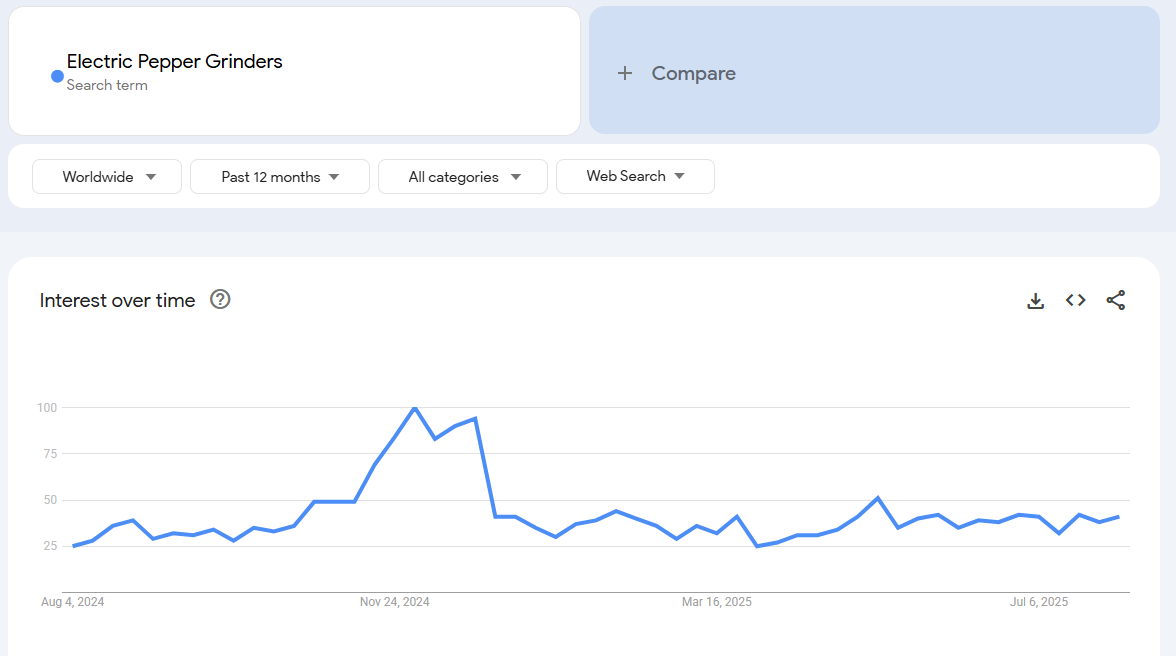
Google Trends for “Electric Pepper Grinder” shows a gradually rising baseline with distinct seasonal spikes (likely around holiday seasons) and a higher high by late 2024–2025. Current interest is up (18K searches/mo), trending positively. An electric pepper grinder may not sound glamourous, but it’s a sleeper hit in kitchen gadgets. These battery-powered (or rechargeable) devices automatically grind pepper (and other spices like salt) at the push of a button, often with a built-in light for precise seasoning. What’s driving the trend for something as simple as a pepper mill? A mix of convenience and demographic shifts. Firstly, they’re easier to use than manual grinders – no twisting required – which appeals to people with arthritis or limited hand strength. Notably, arthritis diagnoses have increased worldwide (over 130% in 35 years) and as the population ages, ergonomic, easy-to-use products are on the rise. An electric grinder is exactly the kind of small quality-of-life upgrade that older adults (or anyone who cooks a lot) appreciate. Google Trends shows interest in these devices growing in tandem with the aging population trend and perhaps also with the general uptick in home cooking. Secondly, they’ve become a bit of a modern kitchen luxury. Cooks enjoy the one-handed operation when multitasking at the stove. Some models are quite stylish, made of stainless steel or even have USB charging, which catches the eye of gadget lovers. We also see seasonal spikes in searches (the chart shows regular peaks, likely around November/December). That suggests electric grinders are popular holiday gifts – a perfect stocking stuffer for parents or a housewarming gift. For sellers, this product hits the giftable home gadget category. You can market it as a solution for those with grip issues (playing up the ergonomic angle) and as a sleek upgrade for foodies who want the latest gear. It’s relatively affordable and compact, making it good for online sales. Pairing it with other kitchen trend items (like continuous spray oil bottles, which incidentally also arose due to ergonomic needs) can increase cart value. The trend trajectory is modest but positive – it’s not a viral product that will vanish next year, but a steadily growing niche that could become standard in kitchens. And since pepper and salt are pantry staples, an improved way to dispense them has broad appeal. In 2025, as more households look to smarten up even the simplest tasks, electric pepper grinders are nicely positioned to season your product lineup with steady sales.
13. Padel Rackets
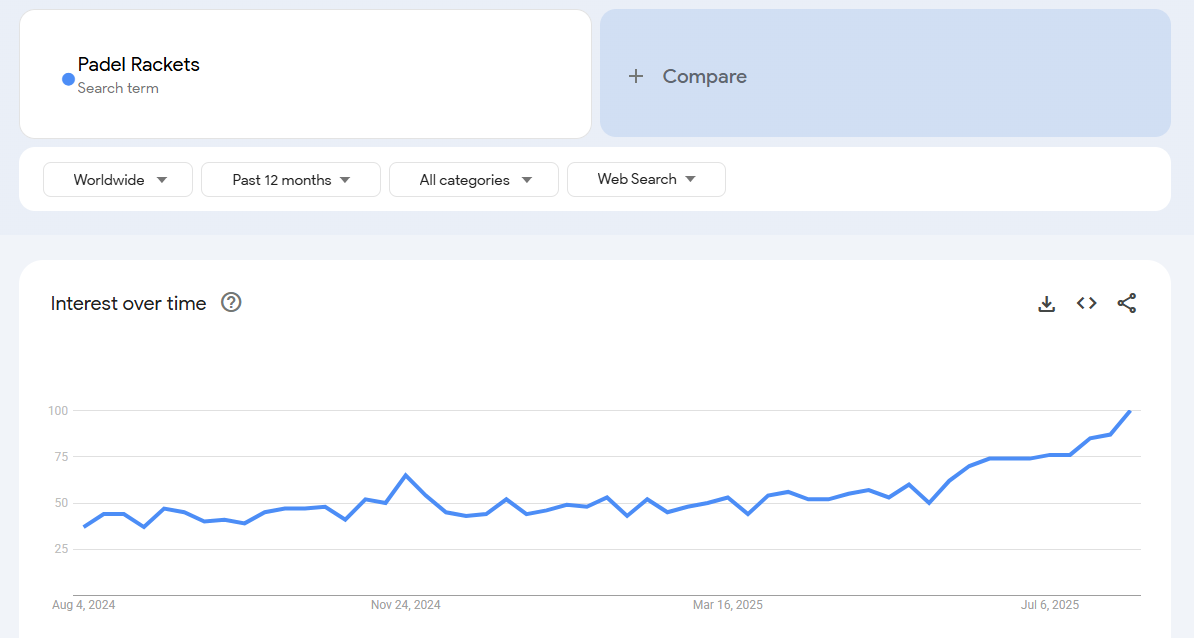
Padel rackets are a product tied to one of the fastest-growing sports in the world: Padel. If you haven’t heard of padel yet, chances are you will soon. It’s a racket sport that’s kind of a hybrid of tennis and squash, played on a smaller court enclosed with walls (the ball can bounce off them, similar to squash). The rackets used are distinctive – they’re smaller than tennis rackets, solid (no stringing), and often have perforated holes. Google Trends and sports data show padel’s popularity skyrocketing internationally, particularly in Europe and Latin America. For example, countries like Spain, Italy, Sweden, and Argentina have seen padel courts pop up everywhere, and the sport is now spreading in other regions too. Padel rackets (sometimes spelled “paddle racket”) have thus become a hot commodity. Searches for them are up dramatically (one source noted a 56% growth in search interest over a year, reaching ~336K monthly searches as of early 2025). What’s fueling this? Padel is often cited as easy to learn and very social, making it appealing to a wide range of ages and skill levels. It’s usually played as doubles, and the smaller court means less running than tennis – a big plus for casual players. This inclusivity has led to a boom in participation. In fact, padel has been called one of the fastest-growing sports globally, and TikTok videos about padel gear and tricks have garnered millions of views, further spreading its appeal. For sellers, padel rackets represent a timely opportunity. While brands like Head and Babolat have padel gear, in many emerging padel markets there’s room for new or localized brands. Aside from rackets, there’s associated gear: padel balls (slightly different from tennis balls), racket covers, and accessories like overgrips. One thing to consider is regional demand – padel is huge in some areas and nascent in others. If you can target regions where interest is spiking (say, North America and Asia are catching on after Europe’s lead), you could capture a growing customer base. Also, padel enthusiasts often upgrade their rackets as they improve or want the latest tech, which drives repeat sales. Google Trends by region can show you where padel searches are highest and rising – focus your marketing there. With padel’s trend line still sharply up, selling padel rackets (and related gear) in 2025 could put you ahead of the sporting goods curve.
14. Toe Spacers
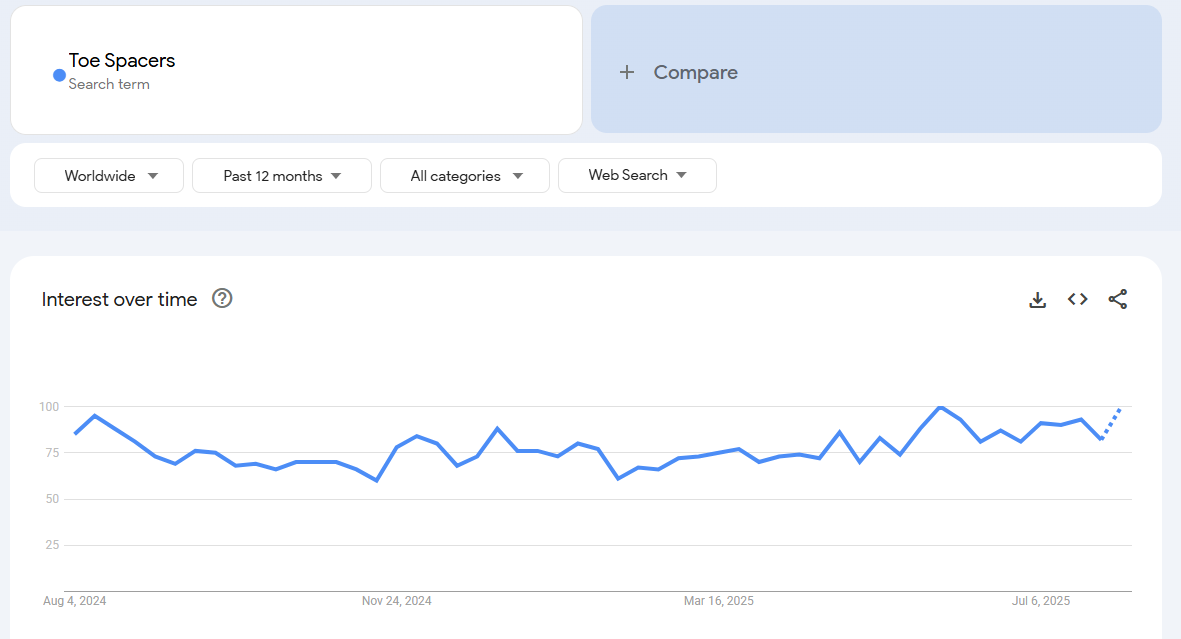
Toe spacers (also known as toe stretchers or separators) are a quirky yet increasingly popular health and wellness gadget. They’re typically made of silicone or gel and fit between the toes, gently spreading them apart. Why would anyone want this? It turns out toe spacers can help alleviate foot pain, improve foot alignment, and even aid balance by restoring the natural splay of toes that’s often constricted by shoes. In recent years, the idea of foot health and “barefoot” or minimalist footwear has gained traction. People are paying attention to issues like bunions, hammertoes, and general toe deformities caused by years of narrow shoes. Toe spacers offer a simple, non-invasive way to counteract those problems. Google Trends and other market indicators show a surge of interest in toe spacers, marking them as a trending product within the broader wellness category. One reason for the rise is the heavy promotion of toe spacers in the yoga and running communities – they use them to strengthen the feet and improve posture. Also, as more folks worked from home barefoot or in socks, they became more aware of their foot comfort and anatomy. Social media played a role too: some viral videos demonstrated toe spacers as a cure for foot fatigue or as part of self-care routines (imagine spa day but for feet). In fact, TikTok videos related to toe spacers amassed over 2.5 billion views, indicating a huge interest and curiosity. For sellers, toe spacers are cheap to produce, light to ship, and appeal to a wide demographic (anyone from athletes to the elderly can use them). You can differentiate by quality of material (medical-grade silicone, for instance) or include exercise guides/foot stretches with the product for added value. They also pair well with other foot care products like bunion correctors, arch supports, or foot massagers. Seasonality might have some effect (perhaps more searches in summer when open-toe season makes people think of foot appearance and comfort), but overall the trend is upward. As a product that promises pain relief and improved physical well-being, toe spacers strike a chord with the wellness trend of 2025. They indicate how even niche items (like a simple gel separator) can find a broad audience when they solve a real problem. According to one e-commerce blog, toe spacers’ surge in interest is a sign of the growing market for products that promote foot health and alignment – a niche worth stepping into.
15. Rotating Car Seats
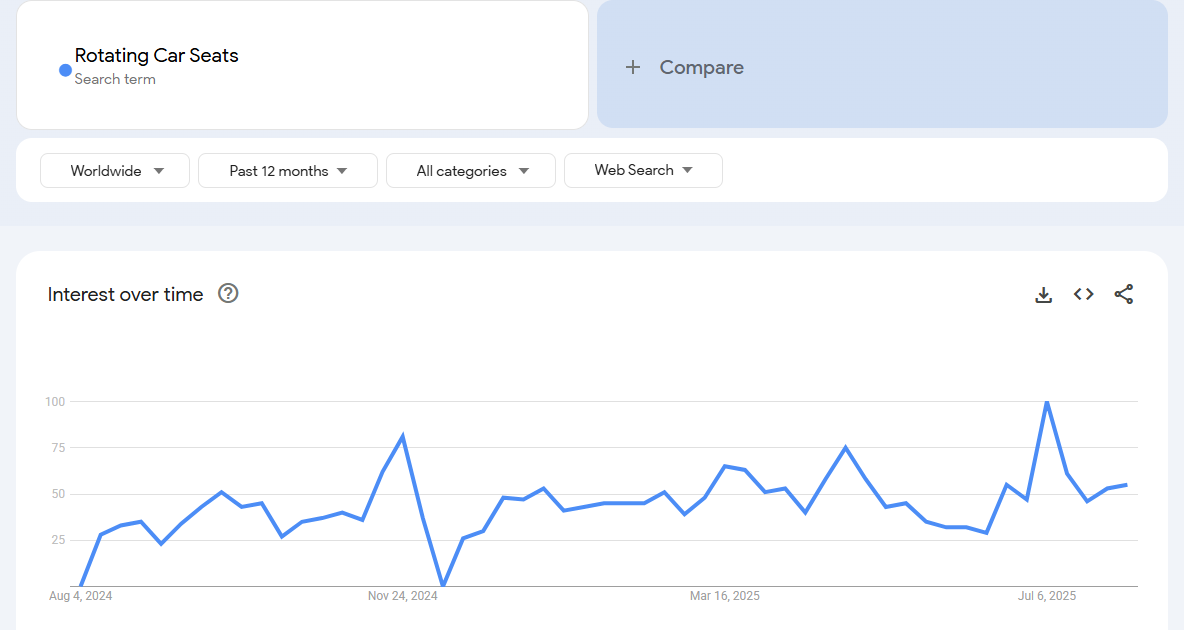
Rotating car seats for infants and toddlers are revolutionizing the child car seat market – and Google Trends data suggests they are on a steep rise in popularity. A rotating car seat is an innovative baby car seat that swivels on its base, usually 180° or a full 360°. The big benefit? It allows parents to rotate the seat toward the car door when strapping the child in, and then rotate it back into a locked position (rear- or forward-facing) for travel. Any parent who has wrestled with getting a squirming baby in or out of a car seat can immediately see the appeal here – it’s about convenience and saving your back. These seats also make it easier to ensure the harness is snug and properly positioned, since you can face the seat toward you instead of awkwardly reaching. The interest in rotating car seats has been fueled by parent reviews and social media demos showing how much simpler it makes the daily routine. In fact, trends analysis indicates a steep rise in search interest, pointing to a growing market for innovative child safety products. Additionally, many rotating models allow extended rear-facing (since you can keep a child rear-facing longer if it’s easier to get them in/out), aligning with safety recommendations. Brands like Graco, Cybex, and Evenflo have launched rotating seat models, often at the higher-end price point, indicating that consumers are willing to invest more for this feature. For e-commerce sellers (especially those in the baby niche), rotating car seats are a great item to highlight in 2025. They tap into that powerful trifecta of parent concerns: safety, convenience, and comfort. While they are bulkier to ship and a more considered purchase (parents do a lot of research on car seats), the trend upward means more parents are aware of and seeking out this feature. A quick stat: one trend report noted a 645% growth in searches over 5 years for rotating car seats, which is massive. If you’re an affiliate marketer or content creator, this is a good product to review or compare (since people look for guidance on such high-ticket items). If you’re a retailer, educating customers about the benefits (and compatibility with their vehicle, etc.) will be key. The global market focus is relevant here: developed markets with high car usage are the primary targets, but as car seat usage becomes standard in more places, the best products (like rotatable seats) will have worldwide demand. In summary, rotating car seats align perfectly with the 2025 ethos of using smart design to make parenting a bit easier, and they’re spinning into the spotlight accordingly.
Why Google Trends Is Your Go-To Tool for Product Research in 2025
In 2025, Google Trends has become an indispensable tool for product research – and for good reason. Consumer interests are shifting faster than ever, and traditional market research can’t always keep up. Google Trends fills that gap by providing real-time consumer demand data. It shows you exactly what shoppers around the world are interested in at this very moment, so you can align your store with genuine customer interest. Instead of relying on gut feelings, you’re using hard data from billions of searches.
Here are a few key reasons Google Trends is a must-use for product hunters in 2025:
-
Spot Rising Trends Early: Google Trends lets you spot rising product trends before they go mainstream. By monitoring upward ticks in search interest (especially “Breakout” terms that suddenly spike by 5000%+), you can catch wind of emerging product ideas and be among the first sellers to ride the wave. This first-mover advantage is huge in e-commerce.
-
Gauge Long-Term vs. Fads: Because you can view data over different time frames (past 7 days, 90 days, 5 years, etc.), you can distinguish seasonal fads from sustained growth. A quick Trends check can tell you if a product idea is a one-season wonder or showing a steady upward trajectory year over year. The Google Trends Retail Report 2024 noted how some products (like sunscreen) reached all-time high interest, confirming a durable trend rather than a fluke.
-
Data-Driven Validation: Google Trends is an excellent way to confirm people are actually searching for a product before you invest in stock. If you have a product idea, a Trends query can validate demand: a high or rising interest line means strong consumer curiosity, whereas a flat or declining line might save you from investing in a dud. In short, it ensures you “know (rather than guess)” what your customers want.
-
Understand Seasonality and Regional Interest: Trends also reveals when and where interest is highest. For example, you might discover that searches for “lunchbox” peak every August (back-to-school season) or that “artisan coffee” is searched mostly in specific hip urban areas. These insights help you time your marketing and target the right geographical markets. Knowing a product’s seasonality and hot regions allows you to focus your efforts where demand is highest.
-
Free and Easy to Use: Unlike expensive market reports, Google Trends is completely free and accessible to anyone. It’s also straightforward – within minutes you can compare two products’ popularity, explore related queries for niche ideas, or see worldwide interest on a map. For small businesses especially, Google Trends offers enterprise-level market research at no cost, leveling the playing field.
In a fast-paced e-commerce landscape, using Google Trends in 2025 is like having a cheat code to trending products. It takes the guesswork out of product research and replaces it with concrete evidence of what shoppers are looking for. As one guide noted, it ensures you “ride the wave of demand, rather than fight against it,” which is invaluable for staying ahead of consumer trends. Simply put, if a product trend is gaining momentum, Google Trends will spotlight it – and you can capitalize on that knowledge.
Step-by-Step Guide to Using Google Trends for Product Research
Using Google Trends is quite intuitive. Below is a step-by-step guide on how to leverage it for product research. By following these steps, you can uncover Google Trends product ideas and validate whether a product is trending upward or fizzling out.
1.Go to Google Trends: Navigate to the Google Trends homepage where you’ll see a search bar and trending examples. You don’t need an account to use it.
2.Enter a Product Keyword: In the search bar, type a broad product category or specific item you’re interested in. For example, you might enter “air purifier” or “yoga mat” or a niche term like “sauna blanket”. Press Enter to see the results.
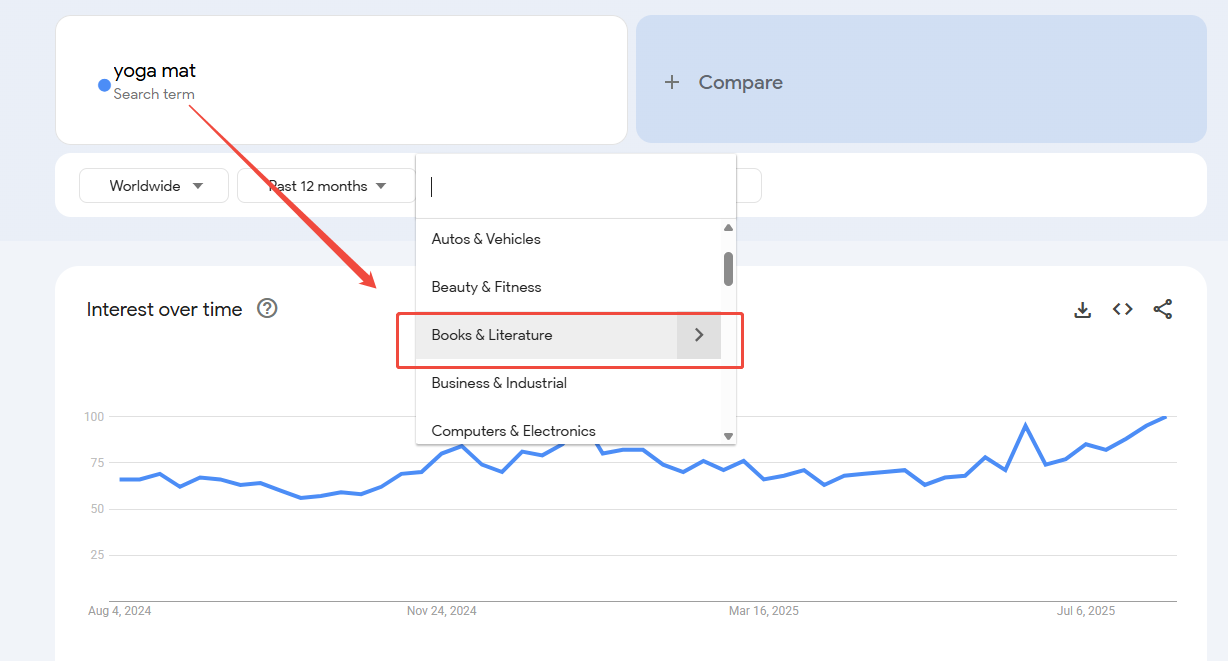
3.Set Timeframe and Filters: At the top of the results, adjust the filters:
- Timeframe: Choose a time range (past 12 months, 5 years, etc.). For product research, a 5-year view is useful to spot long-term trends and seasonal patterns. A shorter view (90 days or 12 months) can reveal recent surges. If you see a consistently upward slope over 5 years, that’s a strong long-term trend. Spikes at regular intervals might indicate seasonality.
- Location: Select Worldwide for a global view or filter by a specific country/region if you are targeting a certain market.
- Category (Optional): If your term is broad, you can refine by category (e.g. “Beauty & Fitness” or “Consumer Electronics”) to get more relevant data. This helps if a word has multiple meanings across domains.
- Search Type: By default it’s Web Search. You can also check “Shopping” search interest or even YouTube search interest if relevant, but Web Search is a good starting point for general product demand.
4.Analyze the Interest Over Time Graph: This graph is the heart of Google Trends. Observe its shape:
- Is the line trending upward overall? A rising line indicates growing interest (potentially a great product to consider). For instance, a steady climb from 2021 to 2025 suggests the product’s popularity is increasing.
- Are there spikes or dips at certain times each year? This could reveal seasonality. For example, a product might spike every December (holiday gift) or every spring (summer-related item). Seasonal products can still be lucrative, but you’ll know to stock up at the right time.
- Is the trend stable or declining? A flat line means consistent interest (could be a saturated market but steady demand), while a downward line might be a red flag that the product is losing favor.
5.Review Regional Interest: Scroll down to the map and regional breakdown. See which countries or states search the term the most. This can uncover target markets. For example, if “home sauna” interest is unusually high in Canada, that’s a clue to focus marketing or inventory there. Use the subregion and city filters for more granular insight – knowing which cities search your product most can help tailor your ads or even plan local inventory.
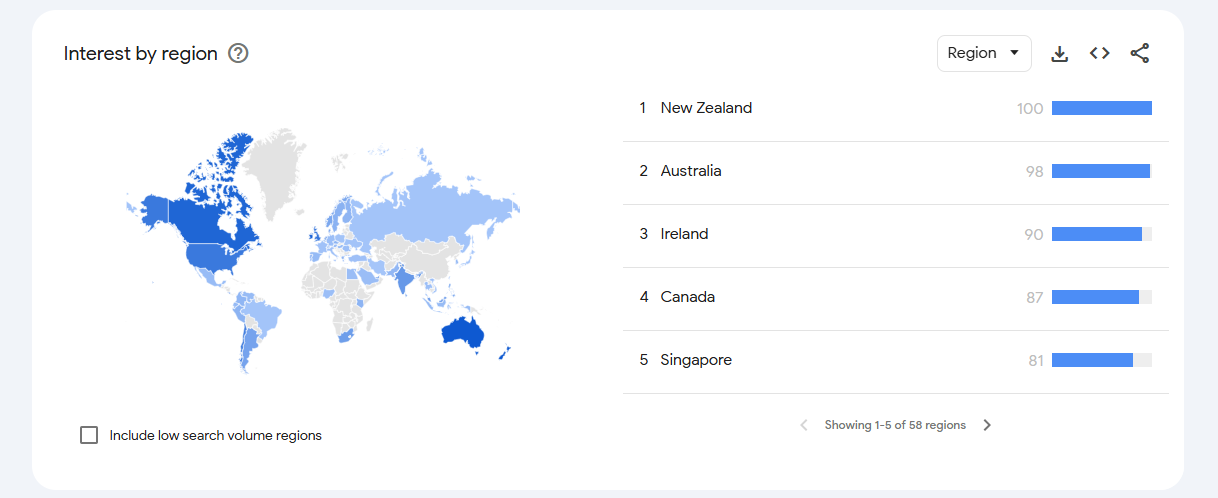
6.Explore Related Topics and Queries: This section is a goldmine for product ideas and niches. By default, it shows “Rising” related queries – terms that have spiked in correlation with your search. These often highlight hot sub-niches or complementary products. For example, if you search “sustainable fashion”, related queries might show “vegan leather bags” trending, tipping you off to a specific product to sell. You can switch to “Top” queries to see the most commonly associated terms for more established interests. Also look at Related Topics – those can be brands or broader concepts to explore. Use the Rising filter to spot breakout terms gaining momentum. If you see a “Breakout” label, it means search interest jumped over 5000% – a strong signal of an emerging trend.
7.Compare Multiple Terms (Optional): If you have a few product ideas, use the Compare feature. Click “+ Compare” and enter another term. Google Trends will display multiple lines in the graph (each indexed to its own highest point). This side-by-side comparison shows which product has higher relative interest or if one is catching up to another. For instance, comparing “electric scooter” vs “electric bike” can tell you which micromobility product has more buzz currently. You can compare up to five terms to see their trend lines on one chart. This helps in choosing the better of two product ideas by data, not hunches.
8.Refine and Repeat: Based on what you find, you might refine your search. Try different keyword variations, including plural vs singular (e.g. “desk chair” vs “desk chairs”), or switch between searching by “term” and “topic” (topics aggregate synonyms). Also consider checking Google Trends’ Trending Searches section for your target country to see current daily spikes – occasionally, a viral product will appear there and you can investigate further. Keep iterating: if “wireless earbuds” is too broad, Google Trends might show rising queries like a specific brand or niche (“sleep earbuds” for instance, as we’ll discuss later).
9.Validate with External Data: While Google Trends is powerful, remember it reflects search interest, not direct sales. Once you find a product with promising Trends data, validate it further. Check Amazon or Shopify for number of competitors, use keyword research tools for approximate search volumes, or see if the product is active on social media. (Google Trends does indicate demand – for example a consistently high search interest often correlates with high sales – but doing this extra homework helps ensure people searching are also buying). In short, pair Google Trends insights with marketplace research to confirm a “trending product” will be a winning product for you.
By following these steps, you’ll harness Google Trends to uncover product opportunities and make data-backed decisions. Even if you’re new to trend analysis, Google Trends’ intuitive interface and visual charts make it easy to use for product research. In essence, you’re using Google’s billions of searches as your personal product research assistant – a strategy every seller should embrace in 2025.
How to Find Trending Products with Google Trends
So how do you actually find trending product ideas using Google Trends? Let’s walk through a practical example, including a screenshot of Google Trends data for illustration. The key is to start broad and then drill down into specifics using the tool’s features we discussed.
Imagine you’re interested in the sleep and wellness niche, and you want to find a hot product in that area. You might start by searching a general term like “sleep aid” or exploring the “Health & Wellness” category on Google Trends. As you explore related queries, you notice an unusual term popping up: “mouth tape”. It turns out that a growing number of people are searching for mouth tape as a solution for snoring and improved sleep quality. This is a great example of a niche product trend that Google Trends can reveal.
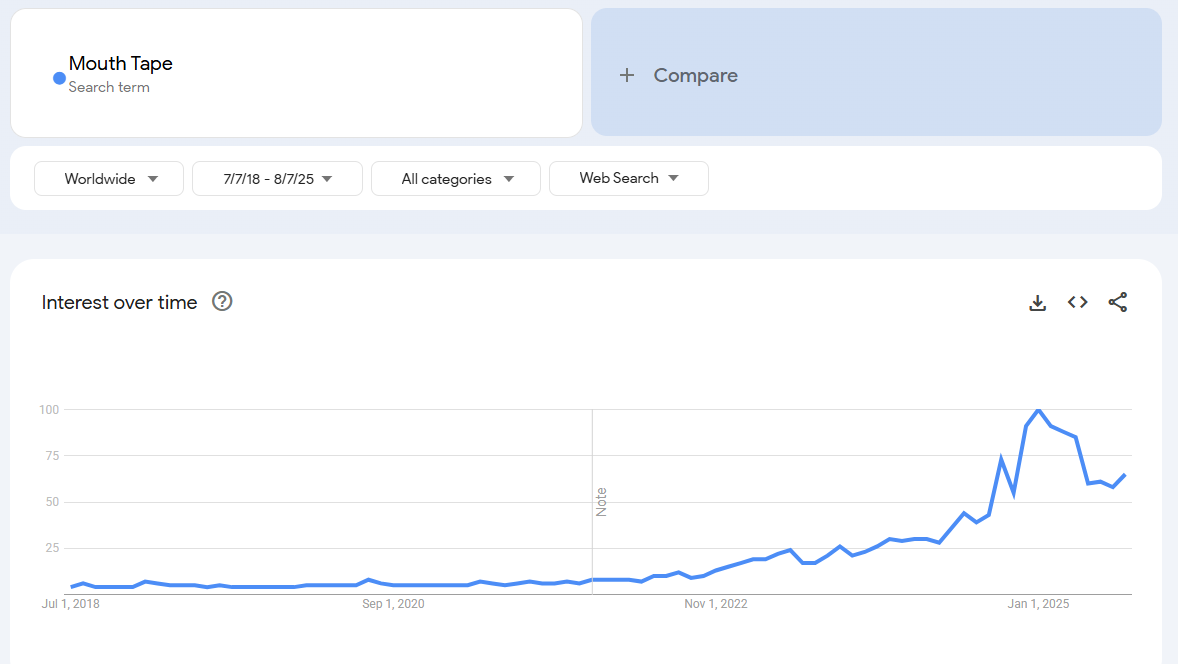
Above: Google Trends interest for "Mouth Tape" (worldwide, 2018–2025). The chart shows a flat baseline for years, then a sharp rise starting in 2022, reaching a current estimated 622,000 monthly searches with 134% year-over-year growth. This steep upward trajectory indicates surging demand for this sleep product.
In the chart above, you can see how Google Trends exposed the rise of mouth tape from obscurity to a breakout trend. A few insights from this example:
-
The Spike – From roughly 2022 onwards, the interest over time line shoots up dramatically. If you were researching in early 2023 and saw that spike, you’d recognize mouth tape as a product worth considering. The data shows it’s one of the fastest-growing sleep trends as people search for ways to reduce snoring and improve sleep quality.
-
Volatility vs. Growth – Notice that before 2022, the line was almost flat near zero – mouth tape wasn’t on anyone’s radar. Then as it gains traction (perhaps through social media or word-of-mouth in the wellness community), the trend line climbs rapidly. Such a pattern – low baseline exploding into exponential growth – is characteristic of a new trend taking off. Google Trends labeled related searches for mouth tape as “Breakout,” which means an increase of over +5000%. This is a strong green light that the product is trending.
-
Related Queries – If you scroll down on Google Trends for “mouth tape,” you’d likely see related rising queries like “sleep mouth tape” or brand names of mouth tape products. In fact, manufacturers have begun marketing “sleep strips,” which are essentially branded mouth tape for night use. This shows how Google Trends not only flags the product idea but also hints at how it’s being positioned in the market (in this case, as a premium sleep solution).
To find other trending products in a similar way, you can repeat this process:
-
Start with a broad category (say, “beauty products” or “fitness gear”) and see what’s trending in related queries. For example, searching the Beauty & Fitness category might surface trending ingredients like “bakuchiol” (a plant-based retinol alternative) or “niacinamide”, which correspond to products like bakuchiol serums or niacinamide creams that are growing in popularity.
-
Use the time filters to identify new upward movements. A product that suddenly doubled its search interest in the past 12 months is worth investigating.
-
Utilize the Rising vs. Top toggle in related queries. Rising will show you newcomers gaining steam, while Top shows established high-volume searches. A savvy product researcher looks at both: Rising for what’s new, Top for what’s consistently popular (and perhaps ripe for a new twist or differentiation).
Let’s say you did the above and identified a bunch of interesting rising terms – how do you know which ones are truly promising? This is where comparing and validating comes in:
-
Compare trends: Put multiple candidate products into Google Trends and compare their graphs. For instance, if you found “sauna blanket” and “cold plunge tub” both trending in wellness, comparing them might show one has a much steeper growth curve. That one might be the better bet.
-
Check seasonality: Ensure you’re not mistaking a seasonal spike for a long-term trend. If interest in “garden lights” spiked last June, that could be a summer seasonal trend. Google Trends’ Year-over-year comparison (looking at the same month across years) can confirm if the spike repeats annually.
-
Research context: Once Google Trends gives you a lead on a product (say, “blue light therapy mask”), dig deeper. Are influencers talking about it? Is it viral on TikTok? Trends data often mirrors social buzz – e.g., silk sleep bonnets trended upward thanks in part to TikTok tutorials extolling their haircare benefits. This context helps you understand why a product is trending and how to market it.
By using these methods, finding trending products with Google Trends becomes a systematic process. The screenshots and graphs you gather from Trends are like detective clues, each line rising or falling tells a story about consumer behavior.
FAQ – Using Google Trends for Product Research
Q1: How do I search Google Trends for products to sell?
A1: To use Google Trends for product research, go to the Google Trends homepage and enter a broad product keyword or niche idea into the search bar. For example, type a term like “air fryer” or “sustainable fashion” – whatever product area you want to investigate. The results will show a graph of search interest over time for that term, plus breakdowns by region and related queries. From there, refine your search: adjust the time frame (e.g., past 5 years for a long-term view), and look at Related Queries with the “Rising” filter to spot associated product terms that are gaining momentum. You can also compare multiple product keywords to see which one has more interest.
Q2: Why is Google Trends useful for small business owners?
A2: For small businesses, Google Trends is like a free market research tool. It helps you find trending products and topics without spending on surveys or reports. You can discover what your target audience is interested in right now by observing search trends. For instance, a small online boutique could use Trends to identify which fashion items are heating up (maybe “bucket hats” or “90s jeans” are spiking in searches).
Q3: How can I tell if a product is truly popular or just a fad using Google Trends?
A3: Google Trends can help you distinguish a lasting popular product from a short-lived fad by the shape and duration of its interest graph. Here’s what to do: set the timeline to a longer range (5 years or more). If the search interest line shows consistent or growing interest year over year, that indicates the product has stable popularity (or a healthy growth trend) rather than a one-off spike. For example, a product with a graph that steadily climbs or at least repeats seasonal peaks annually is likely a solid bet. In contrast, if you see one huge spike that then falls off quickly, that could be a fad or viral moment that fizzled out. You can also check if the term has a “Breakout” tag (extremely rapid growth) and then see if it sustains that growth beyond a few months.
Q4: How do I find niche product ideas on Google Trends?
A4: To uncover niche products using Google Trends, start with a broad category, then let Google Trends guide you into subtopics. For example, search a category term like “home fitness” or “baby products”. Then scroll to the Related Topics and Related Queries sections. Switch the Related Queries filter to “Rising” – this will show you specific searches within that category that are gaining interest quickly.
